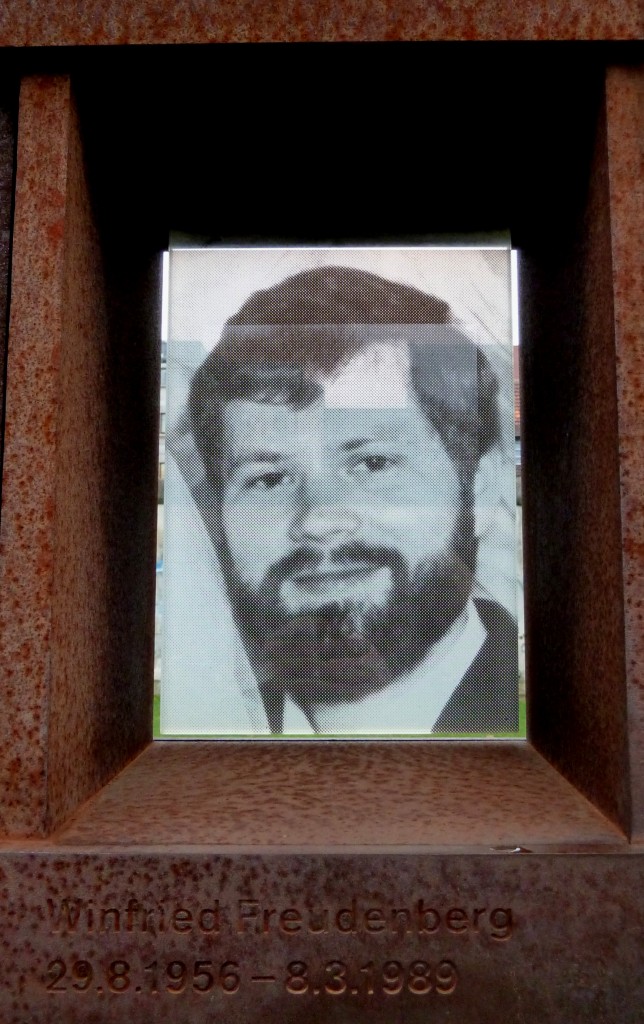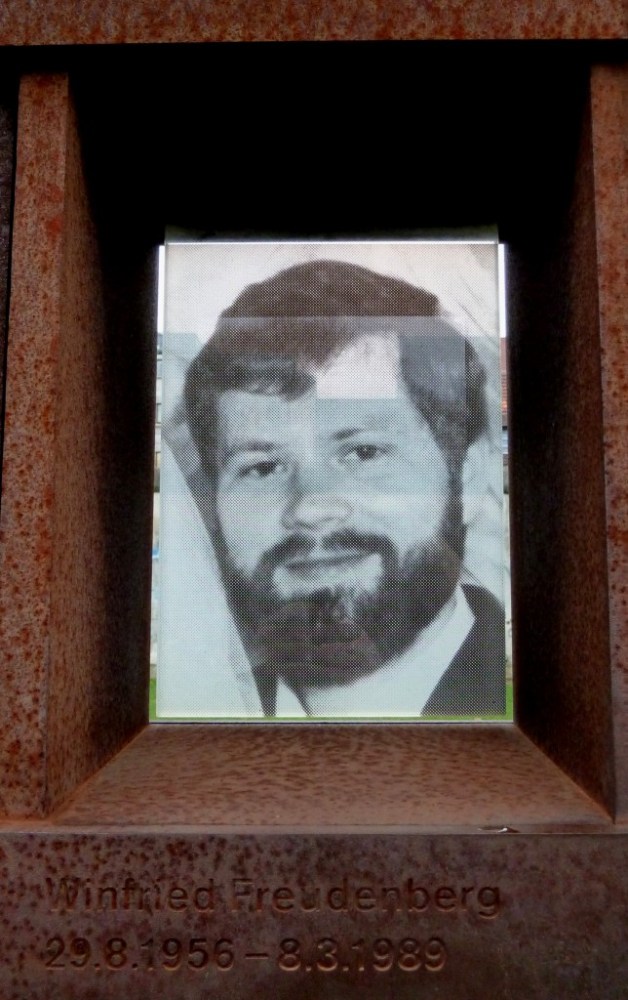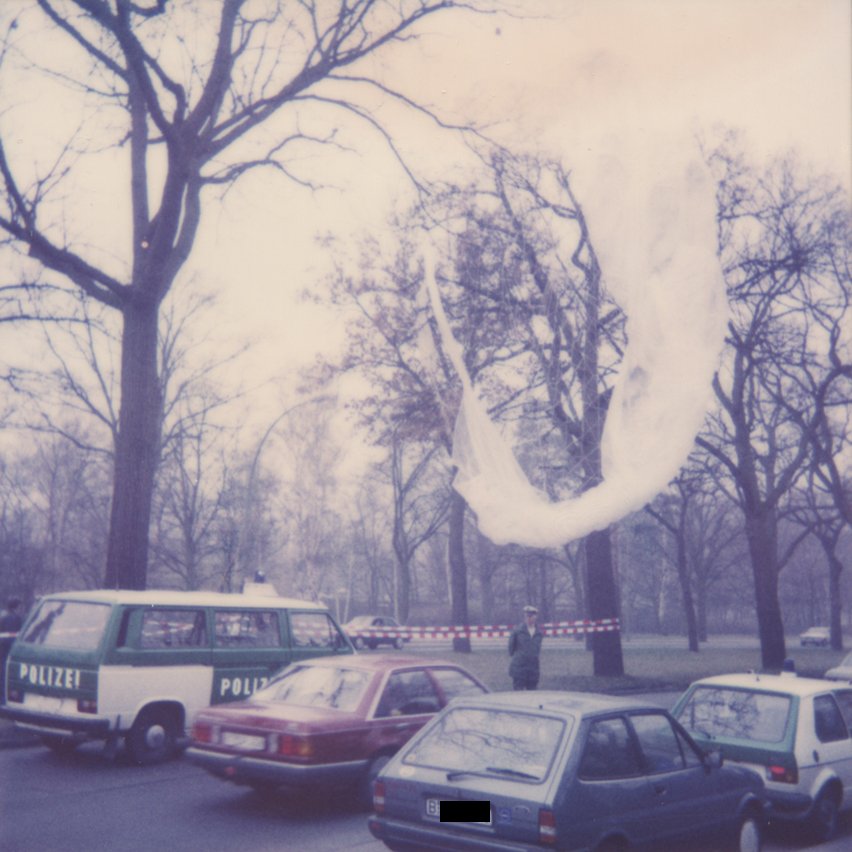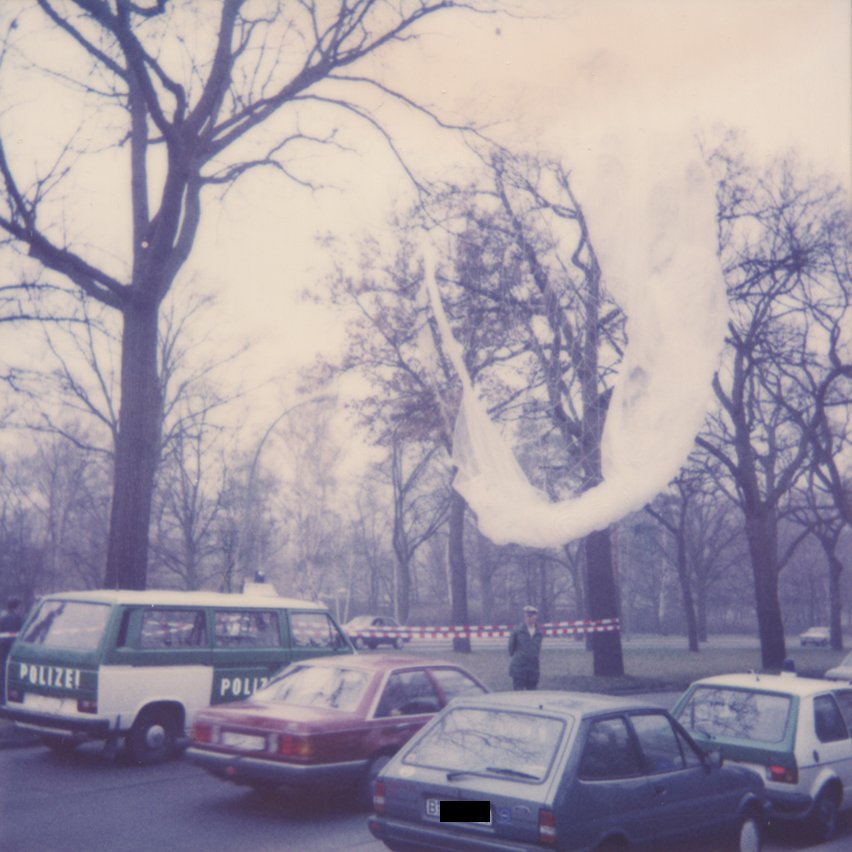08/03/89 Winfried Freudenberg the last victim/das letzte Opfer

Flight and Crash with a DIY balloon
The story of Winfried Freudenberg‘s life, flight and death is a tragic example of East-German ingenuity. Born in 1956 he later studies electrical engineering in Illmenau where he meets his future wife Sabine, a chemist. Even though thoroughly rooted in their community they had difficulties accepting, that their government wouldn’t let them travel and/or exchange with their western counterparts in the scientific community, thus effectively stopping them from doing their jobs.
Just weeks before their wedding in 1988 Winfried was allowed a visit in West-Germany. A perfect opportunity to leave – but not without his fiancé. Shortly after the wedding they decide to try building a gas-balloon. Freudenberg starts working at a gas supply in Prenzlauer Berg to gain access to gas. At the same time they cut connections to familiy and friends to protect them from Stasi scrutiny that would surely follow their escape. If the fear of treachery played a role as well, can’t be verified but it seems likely.
The couple started buying small amounts of plastic sheet, normally used for ponds or flower beds. These were cut into long and 2m wide ribbons and then connected with adhesive tape to create a balloon, 13m high with a diameter of 11m. Just imagine the pressure you must feel to undertake such an endeavour, without telling anybody, all the while fearing discovery by the authorities or a neighbour who walks in at the wrong moment.

Portrait of the last victim of the Berlin Wall: Winfried Freudenberg.
In the evening of March 7th, they pack their Trabant car with all their gear, while a moderate north-eastern wind blows just right to send them to the West from their starting point near Blankenburg station. There is a gas supply for which Freudenberg has a key from his job. It takes over an hour until the hull rises – which creates a new problem: visibility. A barman sees the structure and calls the police.
Shortly after 2.00 am the first police car arrives, but there is not yet enough gas in the balloon to carry two. They decide Winfried has a better chance alone, they cut the holding lines and the balloon gets clear for the moment. But now it rises much too fast and even touches a grid line, creating a black out in a neighbouring district. Nonetheless he soon sees Tegel airport below, but the line to regulate buoyancy doesn’t work, so he drops more ballast in the hope someone sees it falling. But nobody does and he is rising even faster now, probably to a height of about 2.000 m, where high winds catch him and blow him about.
For hours Winfried drifts this and that way over Berlin in the blistering cold. Around 7:30 the next morning he crashes in the southern district Zehlendorf (West) only a couple of 100 m from the border. It’s not entirely clear how he crashed, but the most likely explanation is, that he finally managed to let off gas, which then escaped way too fast. Near the ground he probably catches a fast updraft, which nearly instantly turns his forward motion upwards, throwing him out of the balloon. Not a bone in his body remains unbroken and all internal organs suffer major damage. Winfried was probably dead instantly.
His wife is caught and sentenced to three years parole but later pardoned. Winfried’s body is transferred back to the East where it is kept under close scrutiny of the Stasi. And of course the whole family is questioned by the authorities. For me this is one of the most powerful victims’ stories for a number of reasons. First of all it is extremely tragic and sad. Just months before it would’ve been over anyway, this young couple was so desperate for a different life, they were willing to risk everything – their life, their freedom. And Winfried could’ve easily stayed in the West when he was visiting in 1988, but didn’t want to leave without his beloved fiancé. Secondly, it’s the ultimate example of creativity and craftsmanship, I mean, could you pull something like this off? I couldn’t – even with the appropiate Youtube tutorials.

Leftovers of Winfried Freudenberg’s gas balloon. before police claimed it. The last victim of the Berlin Wall has an extremely touching story. (source: private/unknown)
In the chapel at the official Berlin Wall Memorial (Chapel of reconciliation ~Kapelle der Versöhnung) services are held for the victims from Tuesday to Friday at 12 pm More about Winfried Freudenberg: Wikipedia or the Berlin Wall Memorial.
Winfried Freudenbergs Tod und Flucht im Gas-Ballon
Die Geschichte von Winfried Freudenbergs gescheiterter Flucht in einem selbst gebauten Gas-Ballon ist einerseits besonders tragisch, andererseits ein großartiges Beispiel für den Erfindungsreichtum und die Risiken, die Leute wie Du und Ich aufnehmen, um sich die Chance auf ein besseres Leben zu schaffen. Geboren 1956 im Harz, studiert Winfried Informationstechnik an der Uni Illmenau, wo er auch seine spätere Frau Sabine kennenlernt. Kurz vor der Hochzeit im Herbst 88 ist Winfried bei Verwandten auf West-Besuch und beschließt zu fliehen- nicht jedoch ohne seine Verlobte. Zurück in der DDR beschließen die Beiden, die Flucht mit einem Ballon zu wagen, der aber noch zu bauen ist.
Zunächst besorgt Winfried sich eine Stelle beim Energiekombinat, um Zugang zu den benötigten Mengen Gas zu bekommen. Das Paar zieht um nach Prenzlauer Berg und beginnt heimlich Folie zu kaufen, wie man sie für Beet- oder Teichabdeckungen braucht. 13 m lange und 2 m breite Bahnen werden mit Industrieklebeband und Paketschnur (!) zu einem Ballon mit 11 m Durchmesser verschweißt. Parallel brechen Winfried und Sabine allen Kontakt zu Freunden und Verwandten ab, um diese nicht der Verfolgung der Stasi auszusetzen und vermutlich auch, um nicht verraten zu werden.

Winfried Freudenberg’s gas balloon in a gymasium, where the police tried to reconstruct the events of March 7th. (Foto: Polizeihistorische Sammlung/Der Polizeipräsident in Berlin)
Am Abend des 07. März packen die Beiden alles Nötige in ihren Trabi und fahren nach Blankenburg. Dort verschaffen sie sich mittels eines Schlüssel von Winfrieds Arbeitsstelle Zugang zu einem Gaslager und beginnen den Ballon zu fühlen. Über eine Stunde dauert es bis die Hülle sich aufrichtet, ist nun aber weithin sichtbar. Gegen 1:30 Uhr sieht ein Barmann auf dem Heimweg das seltsame Konstrukt und erinnert sich an eine andere spektakuläre Flucht mit einem Ballon und verständigt die Polizei.
Um kurz nach zwei trifft der erste Wagen der Volkspolizei ein, bevor der Ballon ausreichend gefüllt ist. Das Paar beschließt, dass Winfried allein fliegt. Sie kappen die Halteleinen und der Ballon schießt in die Höhe. Beim Aufsteigen streift er eine Hochspannungsleitung, Funken fliegen und der Strom fällt in einer benachbarten Kleingartenanlage aus. Irgendwann sieht Winfried den Flughafen Tegel unter sich und weiß er ist im Westen. Leider ist die Vorrichtung, mit der Gas abgelassen werden soll, defekt. Um irgendwie auf sich aufmerksam zu machen wirft er weiteren Ballast ab und steigt dadurch auf 2.000 Meter auf.
Am Morgen des 08. März schließlich gegen 7:30 stürzt Winfried Freudenberg über Zehlendorf ab, nur wenige 100 Meter vor der Grenze. Genau lassen sich die letzten Minuten nicht rekonstruieren, aber es gelingt ihm wohl irgendwann doch Gas abzulassen, aber so viel, dass er rapide Höhe verliert. Vermutlich trifft er dann eine Aufwärts-Böe, die seine Vorwärtsbewegung abrupt stoppt und Winfried aus dem Ballon schleudert. Mit keinem heilen Knochen im Leib und inneren Verletzungen tritt der Tod vermutlich sofort ein.
Seine Frau wird später zu drei Jahren Haft auf Bewährung verurteilt aber noch im Herbst 89 amnestiert. Winfrieds Leiche wird überführt und unter reger Anteilnahme – natürlich auch der Behörden – in Lüttgenrode beigesetzt. Für mich ist dies eine der tragischsten Fluchtgeschichten überhaupt. Nicht nur, dass Winfried Freudenberg schon im Westen war, aber wegen seiner Verlobten zurückkehrte. Nicht nur, weil wenig später der Fluch vorbei gewesen wäre, sondern auch weil diese Geschichte so krass vor Augen führt welches Potential in diesem Land schlummerte. Aufgrund der Verhältnisse im Osten war ja eigentlich jeder ein Bastler und Organisator, aber die Fähigkeiten, der Wille und das Wissen solch ein Projekt durchzuziehen, spielen dann doch in einer anderen Liga, als Milchkannen zu Fernseh-Antennen umzubauen.
In der Kapelle der Versöhnung an der Mauergedenkstätte finden regelmäßig von Dienstag bis Freitag von 12:00 bis 12:15 Gedenkandachten für die Maueropfer statt. Während der Winterzeit pausieren diese. Weitere Informationen dazu findet ihr hier Mehr Informationen über Freudenberg findet Ihr bei der Wikipedia oder der Gedenkstätte Berliner Mauer
